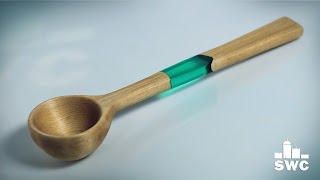In this project I used resin related products from ResinPro:
Tools and materials I propose:
In this video I duplicate a small cross. I first made a silicone rubber mold. Then I cast epoxy resin into the mold to create an exact copy of the original item.
My small cross was missing its hanger. So I used the bandsaw and the belt sander to create a small wood block. This acts as a funnel for the resin and it also gives me some “meat” to create a new more robust hanger.
I used a small plastic piece of packaging as a mould for the silicone rubber. I hot glued the cross into the mold.
I then mixed my two part silicone rubber. The one I used dries white and uses a 1:1 ratio of part A and part B.
I degassed my rubber into the vacuum chamber and then poured it into the mold.
In about 5 hours my rubber gold was ready.
Using an exact knife I carefully cut through the mold in order to remove the cross.
Next I mixed some epoxy resin. I added a drop of white dye and some white mica powder into the resin. I degassed the resin in the vacuum chamber and then poured it into my mold. To prevent the resin from leaking I closed the mold with tape and rubber bands.
In a few days, the resin was cured. I cut the funnel off the casting, drilled the hanger’s hole and shaped the hanger. I polished the casting a little with my micro mesh sanding pads.
To give to my casting a little more character. I first sprayed it with a coat of silver paint. Then I sprayed some black paint on a piece of plexiglass. With a small brush I applied some black paint. While the paint was still wet I wiped it off with a rag. This left some dark spots on the backs. Then with a piece of 400grit sand paper, I sanded the edges of my cross to highlight the high spots.
And I was done. I hope you liked my little tutorial, because that was it, see you soon with a new project video. Until then Merry Christmas and a happy new year.
Disclosure: Some of the links below are affiliate links, meaning, that at no cost to you, I get a small commission if you click through and make a purchase.





















































